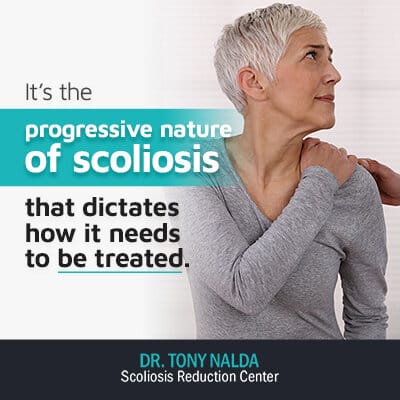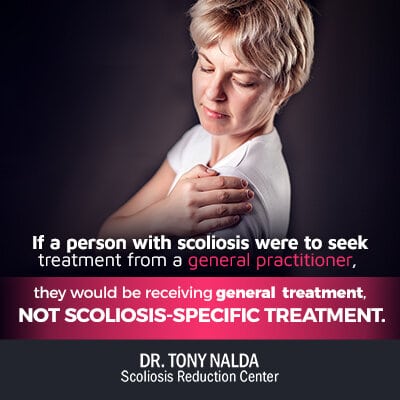When it comes time to commit to a treatment path, choosing a specialist to work with is important. While any general practitioner can treat a patient ‘with’ scoliosis, actually treating a patient’s scoliosis is an important distinction to understand. The difference between seeing a general practitioner versus a scoliosis specialist means the difference between having your scoliosis treated as a symptom, or actually getting the underlying condition assessed and treated.
Scoliosis is a complex condition, one that is still not fully understood. This makes it even more important to seek the help of a specialist who has experience in assessing and treating the condition.
For a clearer understanding of who treats scoliosis and the difference between treating scoliosis as a symptom, or treating its underlying causes, continue reading.
Understanding the Nature of Scoliosis
Firstly, scoliosis is a spinal deformity marked by an abnormally-curved spine coinciding with rotation.
- What this means is that it’s a 3-dimensional condition that involves all three planes of the spine: sagittal, coronal, and transverse.
Secondly, it’s possible for a person to have a curved spine for reasons other than scoliosis, such as chronic bad posture.
- If a person has bad posture and develops a curved spine as a result, this wouldn’t include rotation, which is the big difference.
- An official scoliosis diagnosis will be given if a patient’s X-ray results show a Cobb angle measurement of 10+ degrees that coincides with spinal rotation.
- If the person treating your scoliosis doesn’t treat it as a 3-dimensional condition, or doesn’t have a lot of experience reading a scoliosis X-ray, their treatment plan will fall short.
Effective treatment plans with the potential to address the underlying structural issue of the curvature and functionally reduce it acknowledge the condition’s nature as a 3-dimensional progressive spinal deformity.
Scoliosis is Progressive

One of the defining features of scoliosis is that it’s a progressive condition.
What that means is that there’s no known cure and it’s in the condition’s very nature to worsen over time. It’s the progressive nature of scoliosis that dictates how it needs to be treated.
- Although there’s no known cure for scoliosis, and in the majority of cases, we don’t know what causes it to develop. We do know how to treat it and stay ahead of the curve’s natural tendency to worsen.
- There are a number of characteristics such as the degree of curvature, cause (if known), location along the spine, and age of the patient, affect how much and how quickly one patient’s scoliosis will progress compared to the next.
The progressive nature of scoliosis is one of its more complex features as no one can tell exactly how much a patient’s scoliosis will progress and at what rate.
- There are, most certainly, patterns of and triggers for progression that we recognize, such as age and growth.
- Ultimately, no one can fully predict a patient’s rate of progression.
This is why it’s so important to seek the help of a scoliosis specialist that will give you the best possible chance of developing a treatment plan that addresses and accounts for the condition’s complexities.
Finding a scoliosis specialist who is certified in multiple modalities is the best way to be proactive with your chosen scoliosis treatment path.
- A specialist will understand the condition’s complex nature, be able to comprehensively read a scoliosis X-ray, and will design a customized treatment plan. This is the difference between finding someone to treat your scoliosis as a symptom, or as a condition.
Treating Someone’s Scoliosis as a Symptom vs. Treating Scoliosis as a Condition
Before exploring the different types of scoliosis-specific training and certifications doctors who specialize in scoliosis can get, let’s first clarify the big difference between treating a patient’s scoliosis as a symptom, or treating the underlying condition.

Understanding this distinction is important because it will ensure you know the types of questions to ask and the type of specialist to look for that will give you the best potential for successful treatment.
If a person with scoliosis were to seek treatment from a general practitioner, they would be receiving general treatment, not scoliosis-specific treatment. What that most often amounts to is a doctor who will treat the patient’s curvature as a symptom.
This can include pain-management with medication or injections, ordering X-rays to see how fast the curvature is progressing and how severe it is, and can also include a recommended exercise regime for strengthening the back.
These all sound like good things, and on one level they are, but they do little to address the structural issue of the curvature, and that’s where the treatment approach of a scoliosis specialist will differ.
A scoliosis specialist has the ultimate treatment goal of actually reducing the curvature.
- Here at the Scoliosis Reduction Center®, we achieve this through a customized treatment plan that can include a series of chiropractic adjustments, scoliosis-specific exercises and therapy, and custom 3-D bracing: whatever the individual needs of the patient’s condition dictates.
While I acknowledge that pain management can be an important component of treatment, it’s not as important as addressing the structural issue causing the pain, as reducing the curvature through functional means will lessen any related pain and discomfort along with it.
Finding a specialist who’s certified and trained in scoliosis-specific treatment options will give you, or your loved one, the best chance of achieving a curvature reduction.
Scoliosis-Specific Certifications for Doctors
As previously discussed, there’s a significant distinction between a doctor who treats a patient ‘with’ scoliosis and one who treats that patient’s scoliosis. Any general practitioner can treat a patient with scoliosis, but if you’re looking for someone to treat the underlying condition, a scoliosis specialist trained in multiple modalities is the best choice.
When going through the process of choosing a doctor, it’s important to understand that even a specialist can have experience with only one form of treatment. Patients with scoliosis benefit from treatment given by a specialist with the knowledge and experience to combine multiple therapies for the most customized and best possible treatment plan.
Specialists who are trained in multiple modalities and have experience with different treatment forms have the best results when it comes to managing progression.
Never be afraid to ask just how qualified a doctor is; this is the best way to advocate for yourself or a loved one, and knowing the types of certifications and training options available for scoliosis specialists is the best way to be proactive with your condition.
There are many different scoliosis certifications MDs can receive.
When considering different doctors to treat your scoliosis, following are some of the most highly regarded certification options to look for:
- CLEAR: Chiropractic Leadership, Educational Advancement, and Research focusing on advanced methods of diagnosis, rehabilitation, and treatment for scoliosis
- ISICO: Italian Scientific Spine Institute is an innovative Masters certification in the rehabilitative treatment of non-surgical spinal diseases
- SOSORT: the Society on Scoliosis Orthopedic and Rehabilitation Treatment promotes the advancement of non-surgical management of idiopathic scoliosis
- SEAS: the Scientific Exercises Approach to Scoliosis is an innovative and evidence-based approach to scoliosis management through physiotherapy scoliosis-specific exercises
- ScoliBrace certification in corrective 3D bracing
- Pettibon system certification focuses on assessment and rehabilitation practices that rehabilitate the spine and correct problematic posture
- GOSS: the Gomez Orthotic Spine System is a conservative spinal-deformity treatment approach that promotes spinal stability and balance
- Diagnostic training and certification in MRIs, X-rays, and digital-motion X-ray
- CBP Chiropractic Biophysics certification that focuses on spinal rehabilitation and postural correction
Finding a doctor with multiple certifications has numerous benefits when it comes to treatment efficacy.
If a doctor’s certified in multiple modalities, they can draw from each of those modalities to customize the best possible treatment plan for their patients.
Conclusion
As a leading scoliosis expert, I can honestly say I’ve never treated two patients with the same treatment plan; this speaks to the huge variance that exists from one patient’s condition to the next.
The fact that two patients of the same age and condition form can start out with a 15-degree curve and progress at wildly different rates shows how complex and unpredictable a condition scoliosis can be. This is why choosing a specialist with scoliosis-specific training, certifications, and experience is so important.
While any MD can treat a patient with scoliosis, often the primary focus of general treatment is pain medication and passively observing the condition to see if it gets worse.
This represents the traditional treatment path, one that focuses on treating scoliosis as a symptom and funnels patients towards a spinal-fusion surgery recommendation.
Seeking the help of a scoliosis specialist certified in multiple modalities means taking a proactive approach that involves initiating treatment right away.
Here at the Scoliosis Reduction Center®, we don’t want to waste time treating the scoliosis as a symptom and simply observing its progression.
Our scoliosis-specific chiropractic approach combines different forms of treatment to offer our patients the most customized and effective treatment plans available.
We know that treatment started earlier, before a condition has progressed in severity, has huge benefits in terms of ease and efficacy. If you’re looking for a doctor to treat your scoliosis and keep the aforementioned certifications in mind, you’re already headed down the path most likely to end in a functional curvature reduction.





